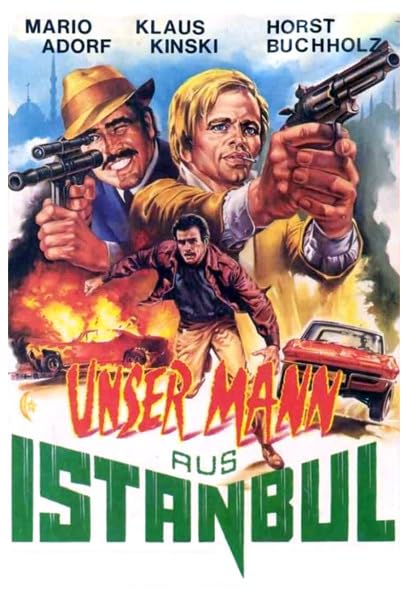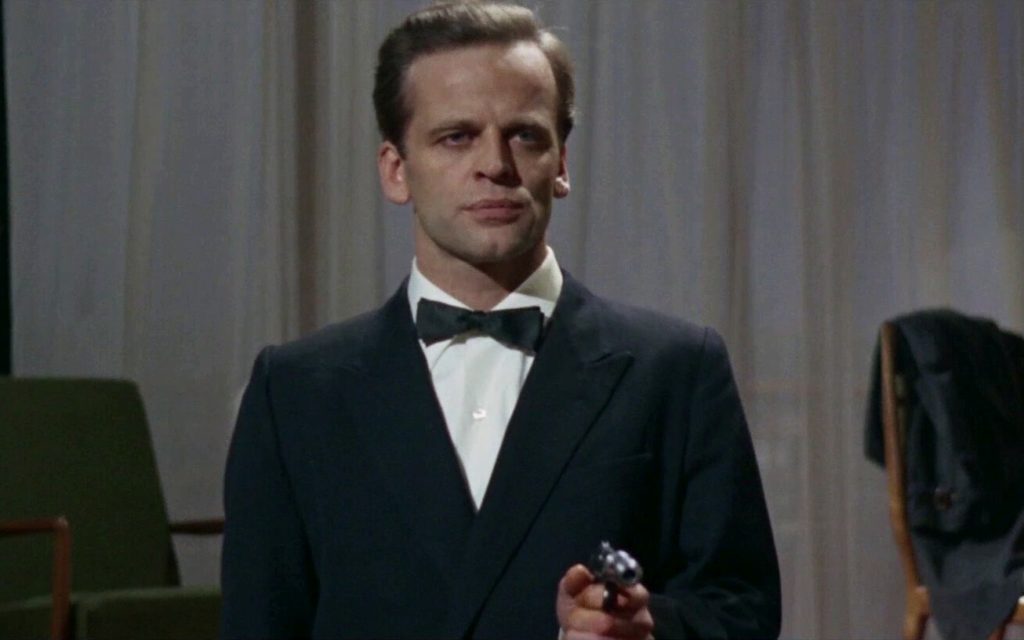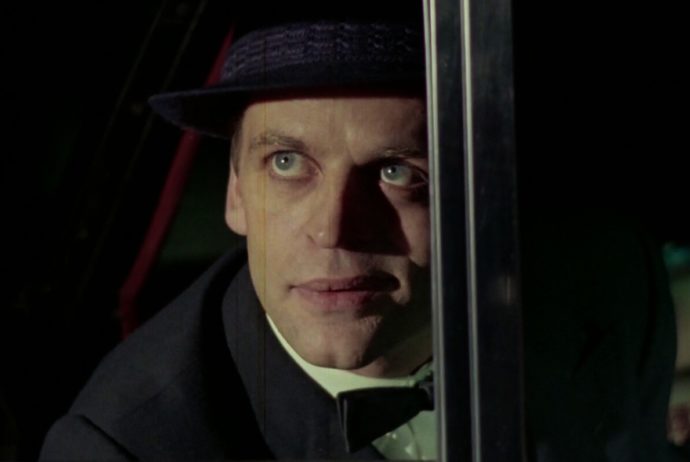Dir: Antonio Isasi-Isasmendi
Star: Horst Buchholz, Sylva Koscina, Perrette Pradier, Klaus Kinski
a.k.a. Estanbul 65
This is one of those Eurospy films which it felt like were being churned out on an almost weekly basis during the sixties. It was likely in response to the success of the Bond movies, and in this case From Russia With Love, released two yeas previously, seems a particular template, at least in its location. Here, things take place largely in – as the title suggests – Istanbul, which had also featured heavily in Russia. It’s probably the best thing the film has going for it, taking full advantage of just about everything the city has to offer: you can almost tick off the landmarks as they appear. I imagine at the time, there was considered to be something exotic about it, straddling the Bosphorus between Europe and Asia. It’s certainly easy to imagine Istanbul being a hot-bed of spies and intrigue.
The movie begins with the exchange of a nuclear scientist, Prof. Pendergast, who has been abducted with a ransom of one million dollars negotiated with the kidnappers. Except, they aren’t playing fair. Overseen from his limo (top) by the mysterious Schenck (Kinski), they return a double, implanted with a bomb which blows up on the plane returning him to safety. The US government is unimpressed, but due to diplomatic concerns, are unable to take action against the most likely perpetrators, the Chinese. I’m not sure why they, rather than the Russians, are deemed culpable. Anyway, Department of State agent Kelly (Koscina) asks for and is sorta-not-really given permission to travel to Istanbul and investigate, in the hopes of getting back both the Professor and the ransom.

Once there, almost all of the actual investigating is delegated to Tony Mecenas (Buchholz). He’s a disgraced American immigrant who was deported for alleged, but denied, mob ties and has set up shop running an illicit casino. He was seen near the site of the plane crash, but says he was just passing by. Tony still holds a grudge against Uncle Sam for kicking him out of the country, but thanks in no small part to Kelly’s feminine wiles, agrees to help out. Initially, this involves recovering a tie-clip camera which had been used to photograph the original swap, and can thus identify the perpetrators. Once that’s in hand, he can then work his way up the chain of command, to find where Pendergast is being held, and rescue the scientist.
Well, that’s the plan, and things don’t go quite as planned, with a slew of escapades, These include Kelly getting kidnapped by the villains, or the unexpected arrival of an Argentinian heiress, Elisabeth Furst (Pradier), who had also apparently been kidnapped by the same gang. She proves susceptible to Tony’s charms as well, though he has his hands full with avoiding numerous attempts on his own life, as he gets closer to the center of the plot. These include both Schenck’s gang and the Chinese, though the relationship between those two is a little vague. The same could be said of most of the plotting here, with confusion over quite what’s going on, by whom and why, being the order of the day.
That said, as long as you’re prepared to go with the flow, and presume things more or less make sense, this is a breezy and generally entertaining piece of fluff. Buchholz was well into his thirties at this point, but looks far too young to be a successful nightclub entrepreneur, least of all one getting involved in international espionage shenanigans. [Matters are not helped by a disturbing resemblance, in some shots, to a young Rick Astley] After being one of the stars of The Magnificent Seven, he was not able to parlay that into a significant Hollywood career. This was in part because he had to turn down the lead in David Lean’s Lawrence of Arabia, due to filming the now all but forgotten Billy Wilder comedy One, Two, Three.
There are some moments where it is clear this is not intended as a particularly serious spy movie. Tony shows up to meet someone who has promised to divulge the whereabouts of the captive, only for the informant to be shot, and the gang of kidnappers try to mow him down with their cars. In the middle, he pauses, before breaking the fourth wall with a “What, me worry?” directed to the audience. He then finds a bulldozer, with the keys apparently left in it, and goes on a fairly impressive rampage of vehicular carnage.

The film has a couple of other nice bits of action. There’s an underwater knife fight in a hotel swimming pool, and the other sequence which stood out is the extended brawl between Tony and Schenck. The former tries to pass himself off as a member of Schenk’s gang, a deception which is rapidly uncovered. He’s about to get an injection of lead for his pains (above), but fortunately discovers that a glass-topped coffee table in Schenk’s apartment is made of particularly thick material, and so bullet-proof. The subsequent fist-fight after the villain runs out of ammo, destroys much of the fixtures and fittings, before Tony is able to prevail by drowning Schenck in the bathroom sink.
There is no definite mention of this film in either version of Kinski’s autobiography. He does say at one point. “A film in Turkey: We shoot in a men’s brothel,” before going on to describe some of his sexual exploits [It’s only present in All I Need is Love] The time-frame might roughly fit, as it comes shortly after Doctor Zhivago, another film from 1965, but it’s hard to tell. There are no scenes involving his character which particularly feel like they were filmed in a brothel, and I doubt he was on set for more than a few days, However, there’s still enough going on, that Kinski’s brief appearances feel like a bonus, rather than the only reason to watch it. With plenty of eye-candy in both feminine and architectural forms, this is more of a pleasure than a chore.
